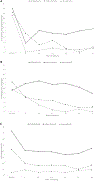Behind the opaque curtain: A 20-year longitudinal study of dissociative and first-rank symptoms in schizophrenia-spectrum psychoses, other psychoses and non-psychotic disorders
- PMID: 32962885
- PMCID: PMC8521436
- DOI: 10.1016/j.schres.2020.07.019
Behind the opaque curtain: A 20-year longitudinal study of dissociative and first-rank symptoms in schizophrenia-spectrum psychoses, other psychoses and non-psychotic disorders
Abstract
Background: Depersonalization and derealization are currently considered diagnostically distinct from first-rank symptoms (FRS) seen in schizophrenia-spectrum psychoses. Nevertheless, the lived experiences of these symptoms can be very similar phenomenologically.
Aims: To investigate the interrelationships between depersonalization, derealization and FRS in individuals with different types of psychotic and non-psychotic diagnoses.
Methods: The Chicago Follow-up Study was a prospective longitudinal research program designed to study psychopathology and recovery in psychiatric disorders consisting of 555 participants, who were recruited at index hospitalization and studied over six follow-up timepoints at approximately 2, 4.5, 7.5, 10, 15, and 20 years later. The primary clinical indices were depersonalization, derealization and Schneiderian FRS that were measured at index hospitalization and at each subsequent follow-up.
Results: 62.8% of participants had at least four follow-ups. There were significant differences in the course and chronicity of depersonalization, derealization and first-rank symptoms across the three diagnostic groups. For the whole sample, derealization was significantly associated with FRS at 2-, 4.5- and 7.5-year follow-up timepoints whereas depersonalization was related to FRS from 10-year follow-up to 20-year follow-up. In participants with schizophrenia, overall depersonalization was more often associated with passivity phenomena whereas derealization was more often associated with overall delusions. There was also a significant effect of time on the associations between depersonalization, derealization and FRS across follow-ups.
Conclusions: Depersonalization and derealization should be viewed as transdiagnostic phenomena that are associated with FRS psychopathology along a continuum, although they are more closely associated with schizophrenia-spectrum psychoses.
Keywords: Depersonalization; Derealization; Dissociation; First-rank symptoms; Psychosis; Schizophrenia.
Copyright © 2020 Elsevier B.V. All rights reserved.
Conflict of interest statement
Declaration of competing interest The authors declare that they have no known competing financial interests or personal relationships that could have appeared to influence the work reported in this paper.
Figures
References
-
- Ackner B. (1954). Depersonalization: I. aetiology and phenomenology. Journal of Mental Science, 100(421), 838–853. - PubMed
-
- Acunzo D, Cardeña E, & Terhune DB (2020). Anomalous experiences are more prevalent among highly suggestible individuals who are also highly dissociative. Cognitive Neuropsychiatry, , 1–11. - PubMed
-
- Aderibigbe YA, Bloch RM, & Walker WR (2001). Prevalence of depersonalization and derealization experiences in a rural population. Social Psychiatry and Psychiatric Epidemiology, 36(2), 63–69. - PubMed
-
- Allen JG (1993). Dissociative processes: Theoretical underpinnings of a working model for clinician and patient. Bulletin of the Menninger Clinic, 57(3), 287. - PubMed
-
- Amiel HF, & Jaloux E. (1927). Philine: Fragments inédits du journal intime Éditions de la Pléiade, J. Schiffrin
Publication types
MeSH terms
Grants and funding
LinkOut - more resources
Full Text Sources
Medical


